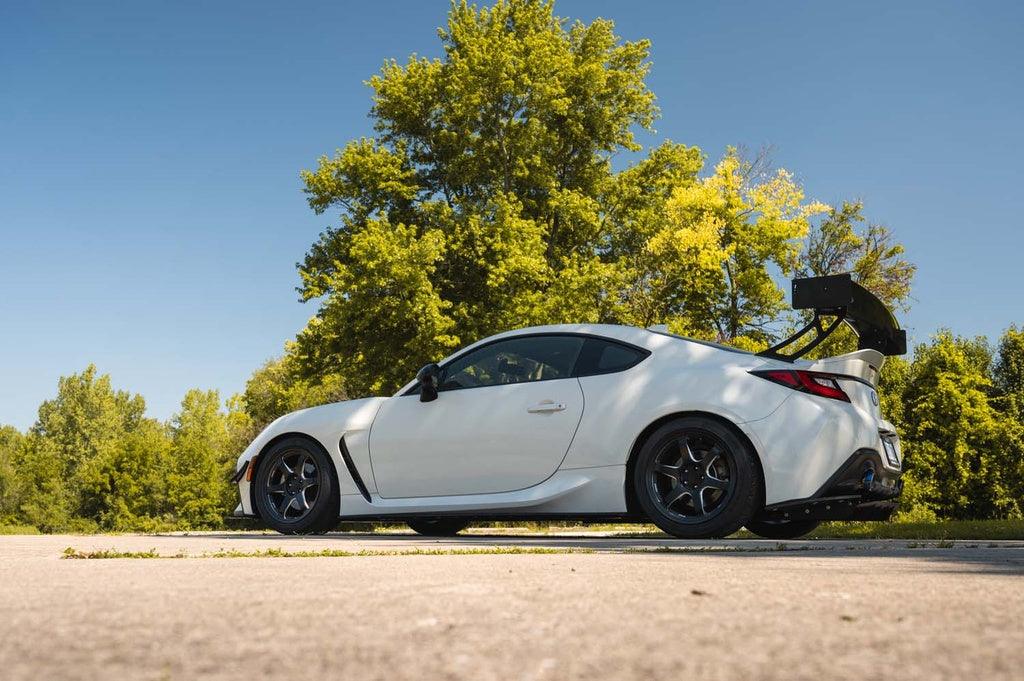UCW Rear Wing Kit - Toyota GR86
Sorry, it's out of stock.
But we can let you know when it's back in.
Couldn't load pickup availability
- Secure Checkout
- Warranty Backed
- Genuine Parts
A0410A-CRB
UCW Rear Wing Kit - Toyota GR86
The UCW Rear Wing is a great addition to your Toyota GR86 to increase downforce significantly in the rear, increase confidence on track, and reduce lap times. Designed to work on the factory trunk and handle the downforce well, the rear wing bolts on easily and improves performance this sports car can utilize on track.
Utilizing state-of-the-art analysis software during the R&D process, we optimized the airfoil for performance for the given build volume which is derived from the V1X. Further utilizing CFD, we ensured the rear wing sees adequate airflow while installed on the car and performs well.
During the design process; we utilized in-house scan data. This results in a product that features a near OEM fit and finish.
The UCW Rear Wing is the perfect addition to the track goer who requires a large bump in rear downforce to balance out a significant front aero package.
Included
- Rear Wing Element Assembly
- Rear Wing Uprights, Machined Aluminum (2)
- Rear Wing Trunk Mount, Machined Aluminum (2)
- Rear Trunk Beauty Plate, Machined Aluminum (2)
- Rear Wing Aluminum Endplate (2)
- Hardware Kit, Includes All Parts Necessary for a Seamless Install
- Includes Drill Template
- Includes Hard Plastic Trunk Stops
Features
- Optimized Airfoil Using ANSYS Adjoint Solver
- Improved Efficiency (L/D)
- Increased Downforce
- Bolts to OEM Trunk
- Capable of Generating and Withstanding 500+lbs of Downforce
- Capable of Balancing Out Significant Front Aerodynamic Systems
Specifications
- Carbon Fiber Rear Wing - 2x2 Twill Pre-preg carbon, Autoclave Cured, Automotive
- High-Gloss Clear
- Machined Billet Aluminum Uprights
- CNC Cut and Bent Trunk Mounts
- Stainless Hardware Throughout
Science
The Verus Engineering UCW Rear Wing was specifically designed for the automotive enthusiast who wants more rear-end downforce. The wing has the capability of operating and generating downforce from 0 to 15 degrees angle of attack. This allows the wing to balance out a variety of front aerodynamic kits.
Our CFD data and our real-world experimental data match up quite well. The wing hit all the major goals we set forth to achieve first in our CFD simulations and then with our real-world testing. The strong correlation between CFD data and real-world testing validates both our CFD analysis approach and the wing’s performance.
Returns
Returns
Effective 3/3/2025, returns are accepted within 120 days of the purchase date. We ask that you return the item in its original packaging. If the item is not in its original packaging or is not in brand new condition, the refund amount will be adjusted to account for repacking costs. Please note:
- Return shipping is to be covered by the customer.
- A 15% restocking fee and the original shipping cost will be deducted from the refund amount.
- If the item is in stock and hasn’t shipped, we offer a refund minus a 4% processing fee.
- We do not accept returns on Racer Special items.
Warranty
Warranty
All of our performance auto parts come with a 1-year limited warranty covering manufacturing defects. If you have a warranty issue or any questions regarding what is covered, please feel free to call, email, or fill out our contact form.
If items are missing from the shipment or the shipment is damaged in any way, we must be contacted within 30 days of the arrival of the product. If we are contacted after 30 days, the replacement parts will be covered by the customer or dealer.
Got a question?
Shipping Notice
Some oversized, heavy, or specialty items may incur additional shipping charges based on your delivery location. If this applies to your order, our team will contact you after checkout with the updated cost. Orders will not ship until additional charges are confirmed and paid.







Shopping Safely
At Revline Performance, we prioritize your safety and security. Here's how we ensure a secure shopping experience:
1. Secure Transactions: We use advanced encryption to protect your personal and payment information, ensuring it is safely transmitted and safeguarded.
2. Trusted Payment Gateways: Our store integrates with trusted payment gateways, ensuring your transactions are processed securely and efficiently.
3. Data Privacy: Your privacy is our top priority. We follow strict data protection policies to keep your personal information confidential and secure.
4. Secure Platform: Shopify provides robust security features and continuous monitoring against vulnerabilities, ensuring a safe shopping environment.
5. Verified Merchants: We are a verified merchant on Shopify, committed to providing authentic and high-quality products.
6. Transparent Policies: Our clear return, refund, and shipping policies provide peace of mind, knowing we stand behind our products.
7. Customer Support: Our dedicated customer support team is ready to assist with any concerns or questions you may have.
Shop confidently at our Revline Performance, where your safety and satisfaction are our top priorities.
$2,314.15
-
FAST SHIPPINGOn thousands of in-stock parts
-
EXPERT SUPPORTReal enthusiasts, real answers
-
AUTHORIZED DEALERSGenuine brands, direct from source


Verus Engineering
When it comes to performance car parts, Verus Engineering stands out as a top choice due to our relentless dedication to quality, innovation, and performance enhancement. Our comprehensive approach to design, rigorous testing, and meticulous manufacturing process ensures that every performance part remains to the highest standard. We start with designs using state-of-the-art methods that are validated and tested under the most rigorous track conditions to guarantee durability and longevity.
When purchasing from Verus, you're not just buying a car part but investing in a meticulously designed product crafted to elevate your vehicle's performance to the next level.
-
Curated from trusted manufacturers
30,000+ Performance Parts
-
Shipped directly from verified suppliers
99% Order Accuracy
-
Driven by real enthusiasts
4.9★ Customer Rating








